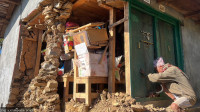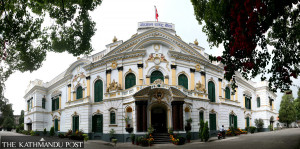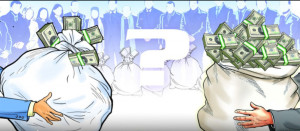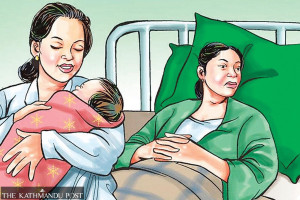Columns
Gen Z movement and the Dalit cause
Has anyone heard a Gen Z activist talk about the persistent plight of the Dalits?
Mitra Pariyar
Many people would like to portray the violent campaigns of September 8 and 9 under the banner of Gen Z—a deadly street protest that overthrew the coalition government within 28 hours—as a great mission against the ruling class. The ashes of Singha Durbar are seen as a beacon of hope. They would insist that the people, the downtrodden in particular, must celebrate this apparent victory. Should we?
As time goes by, the contribution of the Gen Z movement does not amount to much. The only piece of good news is that somehow our national integrity has survived—and so have our hard-earned democratic system and constitution. Democracy has been derailed, and the constitution is still in a coma; however, they are unlikely to die.
I am rather surprised to see many activists and leaders from the oppressed groups and marginalised communities wrongly assuming that the violence has somehow advanced their cause. I have heard Dalit activists proclaiming that the Gen Z movement was against casteism, against Brahmanism, against caste discrimination. Well, think again! On the contrary, I would argue that Gen Z protests have hurt the Dalit cause—further complicating and potentially derailing our struggle for freedom.
Silent Gen Z activists
Has anyone heard any Gen Z activist ever talk about the persistent plight of Dalits in this country and beyond? Does the celebrated mayor of Kathmandu, Balen Shah, who portrays himself as the de facto leader of the Gen Z movement, give any consideration to the problems of Dalit residents of his town, many of whom have been forced to fake their family names to rent properties?
The answer is negative. The Gen Z has been seen unbothered about the issues of equality and social justice. In this regard, the Gen Z movement is worse than other political movements of Nepal’s democratic past.
In their past political struggles against the state, peaceful or otherwise, the political parties raised Dalit issues significantly. They sensitised their Dalit communities and organised them to fight traditional oppression. It is another thing that the parties haven’t done much in terms of practically tackling the issues of caste inequality—untouchability in particular—but whatever Dalits have gained thus far is thanks to the efforts of the political parties.
But, sadly, Gen Z activists, fuelled by postmodern computer technologies, who see the world on their mobile screens, do not even broach the subject of caste discrimination in their discourses. They seem angry about everything except casteism. This silence on the part of the politically active youth, which is otherwise very impatient about the status quo and vocal against poor governance and corruption, is very disturbing and disconcerting.
Silent Gen Z government
Ironically, the Sushila Karki government, backed by Gen Z, is mostly under the control of people beyond their sixties. In the absence of politically experienced ministers, it is struggling to deliver on many of its promises, such that many Gen Z activists themselves are increasingly unhappy. At the same time, the incumbent government is no different from the previous governments in terms of sweeping the issue of caste discrimination under the carpet.
Some credit can be given to this government for having a Dalit minister after a long hiatus. Political parties hardly did that in the past, having an odd Dalit as a junior minister occasionally. But again, like other Cabinet ministers, the Minister for Agriculture, Madan Pariyar, has not spoken a word against caste-based humiliation and exclusion, let alone bring forth any new policies and programmes to contain the longstanding issues of caste.
It is difficult to tell why our Dalit minister is behaving no differently from other ministers from upper or cleaner castes. Was it a precondition for his appointment in the first place? Or does Dr Pariyar lack the guts—like so many of his predecessors—to raise his voice? Could someone ask this question right in his face?
Caste discrimination: A national issue
Some might still contest my argument, maintaining that this is not the time to raise issues of caste and ethnicity and the like. As I have seen on social media, people tend to believe that the current government is mandated just to hold elections on time while paving the way for good governance and control of corruption.
This is where I think everyone has been misguided, where even the Gen Z activists, the Karki government and political pundits seem to have lost their plot.
The misuse of power and the embezzlement of state funds alone are not corruption. In fact, caste hierarchy has been the taproot of nearly all problems in South Asia and, more so, in Nepal—including poor governance and corruption.
How can there be good governance when people are either highly respected and widely accepted or badly humiliated and excluded, based on their birth into certain families? How can there be good governance when people cannot run tea stalls, meat shops and groceries, because of the caste barrier?
There can be no social transformation until the roots of the problem have been targeted. And, until there is social justice and caste/ethnic equality, the cycle of violence and counter-violence will continue forever.
As in previous mass protests and insurgencies, many Dalit youths took part in the Gen Z movement, and they had no qualms about burning down government buildings because the state had never treated them as equal citizens. They were probably keen to burn Singha Durbar down in part because they had never had the opportunity to share state power. They were possibly driven to burn law courts because many individuals of high castes accused of excluding, physically attacking, raping and even murdering Dalits have been set free by the same courts; there has been no justice!
Conclusions
And the same could be said about other marginalised and excluded groups, such as Madheshis, Tharus, Janajatis, women and religious minorities. In a word, issues of inequality and injustice are at the heart of violent uprisings, no matter what their banners or political slogans might be.
Dalits are the most dominated, the most humiliated and the most excluded people in Nepali society. Political parties and government bodies, including the police and courts, have been very unfair to them. Until these systematic issues exist, there can be no peace and progress in the country. I expect the politically active youths to appreciate this reality more than the old players.




 18.12°C Kathmandu
18.12°C Kathmandu















